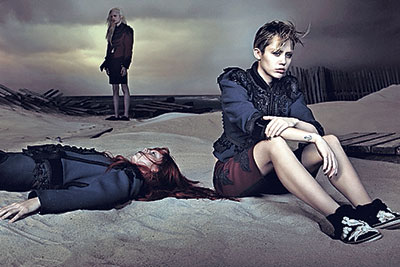The art of new beginnings

Roula Khalaf, Editor of the FT, selects her favourite stories in this weekly newsletter.
To change an image, first you destroy it. Only then can you rebuild: this is the lesson of fashion, and it is the lesson of Miley Cyrus. Who ever thought those two words would reside in the same sentence? My guess is Cyrus herself or her handlers. I think they figured this out long ago.
For the past few months – since that notorious moment at the MTV Video Music Awards when the former Disney darling from TV’s Hannah Montana shed her teddy bear suit to revel a latex bikini and then performed a raunchy routine with Robin Thicke – Cyrus has been at the centre of an intense debate over just how conscious her bad/embarrassing behaviour is, and its intended effect. Cyrus herself has always asserted of her MTV performance that she was playing a character, and it was all planned. Yet she couldn’t quite convince everyone. There were those (such as actress Kate Winslet) who saw Cyrus as the misguided wrecking ball of her own career: a girl on a public path to ignominy, à la Lindsay Lohan, another former child star.
Well, as of this month, I have decided that they are wrong, and Cyrus did, in fact, know what she was doing all along. It was the Marc Jacobs spring/summer campaign that persuaded me – you know, the one that features Cyrus sitting moodily on a beach deserted save for a few shadowy models, staring into the distance while wearing little make-up, some shorts and an elaborate Jacobs jacket; Cyrus lying on the sand in elaborate black beaded Victorian dress. You know, the one that long-term Jacobs collaborator Juergen Teller refused to shoot, because he doesn’t like Cyrus. The one that Jacobs was so committed to, he chose Cyrus over Teller, and got David Sims to photograph instead. What did Jacobs understand that Teller did not?
He saw the forest, not the trees.
I mean, just take a step back from Cyrus’s antics for a moment (because yes, as a mother, I have found all this just ridiculous, and yes, I do spend a large amount of time holding Cyrus up as an example of how you do not behave to my 13- and 11-year-olds). Let’s look at the big picture: Disney star needs to grow up; Disney star does all sorts of bad stuff and alienates her old fan base (and their parents); delinquent star is then picked up out of the gutter, well dressed, and demonstrates heretofore unrevealed depths. That kind of narrative arc doesn’t happen by accident. It happens by, well, design. And it is a familiar fashion blueprint.
Think of it this way: replace “Disney star” with “brand”. Brand needs to become relevant to new audience, so hires new designer; brand’s new designer rejects old aesthetic and alienates former consumers; brand’s new designer creates new look and everyone celebrates. It has, when it comes to old houses and new beginnings, been the story of the decade – since John Galliano transformed Dior’s New Look into Dior’s Matrix. (I will never forget talking to a course instructor of St Martin’s college in London a few years ago, and him observing that now, when his students were being influenced by Dior, it was the Galliano Dior they were referencing. The image of the former Dior was gone.)
…
It’s the story of Riccardo Tisci’s Givenchy, and Hedi Slimane’s Saint Laurent: first comes the outrage and rejection, and then comes the acceptance. It’s the story of Kim Kardashian’s ascent from reality TV to the cover of highbrow fashion magazine W, and Kate Upton going from Sports Illustrated to Vogue. It’s the story, when you think of it, of Jacobs himself: the designer whose grunge collection for Perry Ellis in 1992 provoked such outrage at the time that he was fired – only for him to become the next big initial public offering two decades later. Derision and redemption, that’s how it goes.
Indeed, Cyrus is not the first celebrity in search of a new reputation to notice the pattern: before her there was Victoria Beckham, who successfully separated herself from her former, much-derided-by-high-culture-types Spice Girl self via a Marc Jacobs ad campaign – the one in which she mocked her wannabe image by popping out of a giant shopping bag, thus paving the way for her new identity as a designer. I doubt the transformative power of the campaign, or the man behind it, escaped Cyrus’s notice. Indeed, I’d put money on there being a cause-and-effect relationship here.
Of course, whether it will work in Cyrus’s case is another story. Thus far, in informal Twitter/blogging polls, the jury is out: there are questions raised about her stage costumes (crude) versus her red-carpet looks (better; see the Jacobs she wore to the Met Ball last May). However, it doesn’t seem too far-fetched to think that there’s a likelihood, given the ad campaign, that when her tour starts next month, she might be wearing some Jacobs, as opposed to just underwear, on stage. At which point Cyrus 3.0 will have arrived.
vanessa.friedman@ft.com, @VVFriedman
More columns at ft.com/friedman
Comments